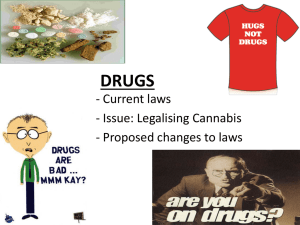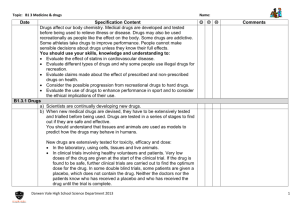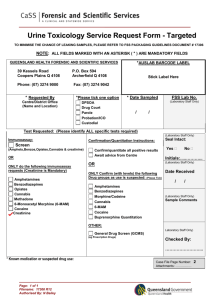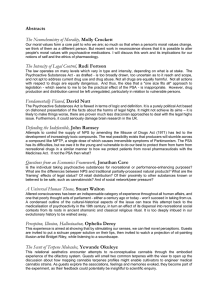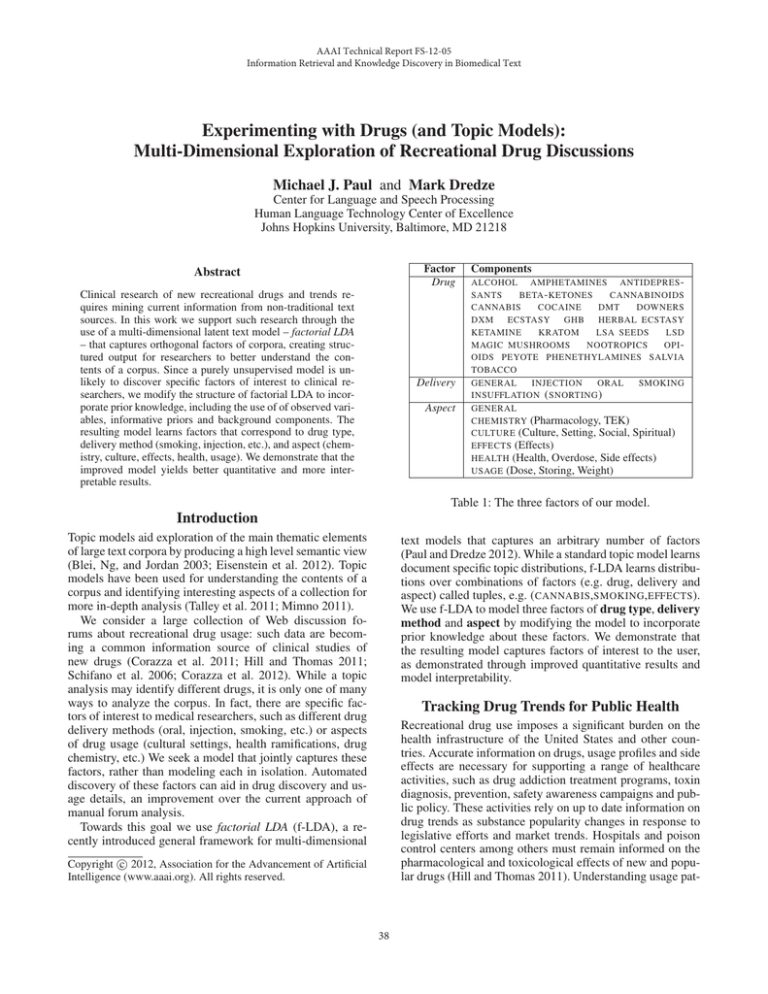
AAAI Technical Report FS-12-05
Information Retrieval and Knowledge Discovery in Biomedical Text
Experimenting with Drugs (and Topic Models):
Multi-Dimensional Exploration of Recreational Drug Discussions
Michael J. Paul and Mark Dredze
Center for Language and Speech Processing
Human Language Technology Center of Excellence
Johns Hopkins University, Baltimore, MD 21218
Factor
Drug
Abstract
Clinical research of new recreational drugs and trends requires mining current information from non-traditional text
sources. In this work we support such research through the
use of a multi-dimensional latent text model – factorial LDA
– that captures orthogonal factors of corpora, creating structured output for researchers to better understand the contents of a corpus. Since a purely unsupervised model is unlikely to discover specific factors of interest to clinical researchers, we modify the structure of factorial LDA to incorporate prior knowledge, including the use of of observed variables, informative priors and background components. The
resulting model learns factors that correspond to drug type,
delivery method (smoking, injection, etc.), and aspect (chemistry, culture, effects, health, usage). We demonstrate that the
improved model yields better quantitative and more interpretable results.
Delivery
Aspect
Components
ALCOHOL AMPHETAMINES ANTIDEPRES SANTS
BETA - KETONES
CANNABINOIDS
CANNABIS
COCAINE
DMT
DOWNERS
DXM
ECSTASY
GHB
HERBAL ECSTASY
KETAMINE
KRATOM
LSA SEEDS
LSD
MAGIC MUSHROOMS
NOOTROPICS
OPI OIDS PEYOTE PHENETHYLAMINES SALVIA
TOBACCO
GENERAL
INJECTION
ORAL
SMOKING
INSUFFLATION ( SNORTING )
GENERAL
CHEMISTRY (Pharmacology, TEK)
CULTURE (Culture, Setting, Social, Spiritual)
EFFECTS (Effects)
HEALTH (Health, Overdose, Side effects)
USAGE (Dose, Storing, Weight)
Table 1: The three factors of our model.
Introduction
Topic models aid exploration of the main thematic elements
of large text corpora by producing a high level semantic view
(Blei, Ng, and Jordan 2003; Eisenstein et al. 2012). Topic
models have been used for understanding the contents of a
corpus and identifying interesting aspects of a collection for
more in-depth analysis (Talley et al. 2011; Mimno 2011).
We consider a large collection of Web discussion forums about recreational drug usage: such data are becoming a common information source of clinical studies of
new drugs (Corazza et al. 2011; Hill and Thomas 2011;
Schifano et al. 2006; Corazza et al. 2012). While a topic
analysis may identify different drugs, it is only one of many
ways to analyze the corpus. In fact, there are specific factors of interest to medical researchers, such as different drug
delivery methods (oral, injection, smoking, etc.) or aspects
of drug usage (cultural settings, health ramifications, drug
chemistry, etc.) We seek a model that jointly captures these
factors, rather than modeling each in isolation. Automated
discovery of these factors can aid in drug discovery and usage details, an improvement over the current approach of
manual forum analysis.
Towards this goal we use factorial LDA (f-LDA), a recently introduced general framework for multi-dimensional
text models that captures an arbitrary number of factors
(Paul and Dredze 2012). While a standard topic model learns
document specific topic distributions, f-LDA learns distributions over combinations of factors (e.g. drug, delivery and
aspect) called tuples, e.g. (CANNABIS,SMOKING,EFFECTS).
We use f-LDA to model three factors of drug type, delivery
method and aspect by modifying the model to incorporate
prior knowledge about these factors. We demonstrate that
the resulting model captures factors of interest to the user,
as demonstrated through improved quantitative results and
model interpretability.
Tracking Drug Trends for Public Health
Recreational drug use imposes a significant burden on the
health infrastructure of the United States and other countries. Accurate information on drugs, usage profiles and side
effects are necessary for supporting a range of healthcare
activities, such as drug addiction treatment programs, toxin
diagnosis, prevention, safety awareness campaigns and public policy. These activities rely on up to date information on
drug trends as substance popularity changes in response to
legislative efforts and market trends. Hospitals and poison
control centers among others must remain informed on the
pharmacological and toxicological effects of new and popular drugs (Hill and Thomas 2011). Understanding usage pat-
c 2012, Association for the Advancement of Artificial
Copyright Intelligence (www.aaai.org). All rights reserved.
38
terns can inform outreach strategies (Bruneau et al. 2012).
A number of sources aid in studying drug trends. The
most accurate information comes from speaking directly
with users, e.g. focus groups (Reyes et al. 2012) or interviews (Hout and Bingham 2012). Alternative, less time consuming, methods include wastewater testing for known toxins (Wish et al. 2012; Zuccato et al. 2011), tracking ICD10 codes from hospitals that correlate with toxicity (Shah,
Wood, and Dargan 2011), or testing chemicals found in ER
patients (Wood et al. 2011). While faster, these methods provide a skewed and incomplete picture.
While online drug discussions were first viewed as a dangerous information source on designer drugs for users (Wax
2002), researchers now recognize clinical value in this information (Corazza et al. 2011). Morgan, Snelson, and ElisonBowers (2010) found drug images pervasive on popular social media websites, and some sites targeted for recreational
drugs provide a detailed picture of drug use. Comprehensive
reviews now include standard (PUBMED) and non-standard
sources: media reports, government publications and drug
user web forums (Hill and Thomas 2011). These forums are
especially helpful for new drugs that arise as legal alternatives to banned drugs (Gallagher et al. 2012). The EU Psychonaut project focuses on categorizing recreational drug information from online forums (Schifano et al. 2006).
Consider an illustrative example from recent work by
Corazza et al. (2012): the new drug methoxetamine, a ketamine derivative. Ketamine is a controlled substance and
methoxetamine is a popular legal psychoactive alternative.
However, methoxethamine has no clinical trials and thus little is known about its use, effects, or popularity. Corazza and
colleagues turned to forums for information on the drug’s effects and usage. A manual analysis of online materials, such
as Drugs-Forum (discussed below) and YouTube videos advertising the drug, uncovered such details.
Organizing and understanding forums requires significant
effort; manual analysis is time consuming. Instead, we propose automated tools for exploration and analysis of these
data. Approaches based on supervised models, popular in
surveillance, cannot capture new drugs of which researchers
are unaware (Winstock and Mitcheson 2012). In fact, existing surveillance through traditional indicators (e.g. hospitals
and law enforcement) fails to identify the emergence of new
drug classes, such as mephedrone (Dunn et al. 2011).
Instead, we rely on unsupervised topic models, where the
identification of thematic elements can uncover emerging
trends. Topic models have been shown to be useful tools
for studying public health in Web data such as Twitter (Paul
and Dredze 2011). However, standard topic models cannot
capture the diversity of factors of interest: drugs, delivery
method, various aspects, etc. Instead, a multi-dimensional
text model can simultaneously capture these different factors, providing a more informative understanding of the data.
In this work, we modify f-LDA to incorporate prior knowledge to discover factors of interest in drug discussions.
members and more than one million monthly readers. The
site is an information hub where people can freely discuss
recreational drugs with psychoactive effects, ranging from
coffee to heroin, hosting information and discussions on specific drugs, as well as drug-related politics, law, news, recovery and addiction. Site users are primarily drug users, but
also include researchers, parents, officials, NGOs, lawyers,
doctors, journalists and addiction specialists. The site has
been used in clinical research (Corazza et al. 2012).
Discussion threads are organized into numerous forums,
including drugs, the law, addiction, etc. Since our interest
was learning about drug use, we focus on the drug forums.
Each thread is assigned to a specific forum (drug) and each
thread has a user-specified tag, which can indicate delivery
method (e.g. “oral”), or general categories like “effects.” We
focused on a few tags of interest, shown in Table 1.
Multi-Dimensional Text Models
We begin by summarizing factorial LDA (f-LDA) (Paul and
Dredze 2012), a multi-dimensional text model that jointly
captures multiple orthogonal semantic factors.1
Consider a standard topic model (e.g. LDA (Blei, Ng, and
Jordan 2003)) where the choice of topics corresponds to selecting entries in an array; document specific topic distributions are distributions over the array. In f-LDA, which
captures K factors, we replace the flat array with a Kdimensional array; document specific distributions are over
the K-dimensional array. Each dimension is called a factor,
the specific choice for an entry along one factor a component, and the combination of a component from each factor
forms a tuple, i.e. an entry in the K-dimensional array. In
our application, the first factor will be drugs, the second delivery method, and the third aspect. An example tuple could
be (CANNABIS,SMOKING,EFFECTS). In the same way that
each topic is associated with a word distribution in LDA,
each tuple is associated with a word distribution in f-LDA.
Formally, θ(d) is a document specific distribution over a
K-dimensional array, and each token is associated with a latent vector ~z of length K; we have K factors, each with Zk
components. The Cartesian product of the K factors forms
a set of tuples and the vector ~z references K components to
form a tuple ~t = (t1 , t2 , . . . , tK ). Each entry in the array (i.e.
each tuple) references a word distribution that is influenced
by the associated components. In this model, a token is generated by first sampling an entire tuple ~z from the document
specific θ(d) and then the token is sampled from the tuple’s
corresponding word distribution φ~z . θ(d) is drawn from the
prior Dirichlet(α̂).
Intuitively, tuples which share components should have
word distributions which share words. The word distributions for the triples (CANNABIS,SMOKING,EFFECTS) and
(CANNABIS,ORAL,CHEMISTRY) should both contain words
about cannabis. f-LDA solves this by utilizing a structured
word prior to encourage similar words to appear in each tuple with the same component. φ~t, the word distribution for
(~
t)
(~
t)
tuple ~t, has a Dirichlet(ω̂w ) prior for word w, where ω̂w
Corpus: Drugs-Forum
Our data set is taken from drugs-forum.com, a site that
has been active for more than ten years with over 100,000
1
39
Full details can be found in Paul and Dredze (2012).
is a log-linear function of three parameter types: ω (B) , a
(0)
corpus-wide precision parameter (the bias), ωw , the cor(k)
pus specific bias for word w, and ωtk w , the bias parameter for word w for component tk of the kth factor – it is
this last parameter which ties together tuples that share the
(~
t)
component
tk . These parameters
are combined as ω̂w ,
P
(0)
(k)
exp ω (B) + ωw + k ωtk w , which forms the Dirichlet
prior for ~t’s word distribution.
Another problem that f-LDA addresses is the fact that
many tuples will have little support in the data, and so the
Cartesian product of factors should be sparse – the posterior “opts out” of some tuples. To handle this, the prior over
tuples becomes θ ∼ Dirichlet(B · α̂), where · is the cellwise product and B is a sparsity inducing K-dimensional
array, where an entry b~t corresponds to tuple ~t. The values of b are in (0, 1), where values close to 1 or 0 represent whether a tuple is active or inactive. If b~t is close to 0,
then θ in each document will have a very low prior probability of choosing ~t. This allows the model to avoid learning word distributions for tuples that do not have support
– for example, (CANNABIS,INJECTION,EFFECTS) does not
appear in the data because cannabis is not injected.
our corpus contains one of the labels in Table 1) and many
messages discuss several components, not just the one implied by the tag. However, we can make use of the tags in a
semi-supervised framework; specifically, we will use these
tags to create prior probabilities over the word distributions
for these components.
Tags and Word Priors We will now describe how to create these word priors based on tags. Assume for the moment
we are given a general distribution over words in the corpus and a distribution over the words associated with a tag.
This is formalized as a vector m of log-frequencies over the
(f )
vocabulary for the whole corpus, and a vector ηi of logfrequencies over the vocabulary for the ith component of
factor f . If we had these values, we could use them to guide
learning as prior knowledge over model parameters ω. While
f-LDA assumes each ω is drawn from a 0-mean Gaussian,
we alter the means of the appropriate ω parameters to use m
and η:
(k)
(k)
(0)
ωw
∼ N (mw , σ 2 ); ωiw ∼ N (ηiw , σ 2 ).
(1)
(0)
Recall that ωw are corpus-wide bias parameters for each
(k)
word and ωiw are component specific parameters for each
word. This yields a hierarchical prior in which η parameterizes the prior over ω, while ω parameterizes the prior over φ
(the word distributions).
In additional to the components which come from the forum tags, we also add an extra component called GENERAL –
with index 0 – to the second (delivery) and third (aspect) factors. General words that are not specific to individual com(k)
ponents will fall to the general components – we set all η0
to ~0, so that there is no prior bias towards certain words.
Performance Enhanced Factorial LDA
We will use f-LDA to model three factors relating to drug
usage. In addition to drug type, the two other factors are
delivery method and general aspects of drug usage. First,
researchers are interested in the method of drug delivery (injection, oral, smoking, etc.) as different delivery methods
can yield different effects. Second, there are many aspects
to drug usage, such as the cultural context, the effects, side
effects, or health implications. Modeling these three factors
yield tuples of the form (COCAINE,SNORTING,HEALTH) and
(CANNABIS,SMOKING,CULTURE).
However, without any supervision, there is no way to ensure that the model will actually discover these three factors.
In this section, we present a 3-dimensional f-LDA model
augmented with prior knowledge, to encourage the model to
learn the factors of interest.
Table 1 shows the different components of the three factors that we are going to model. The many sub-forums
within our data are already categorized (sometimes hierarchically) by drug or drug class, which gives the components
of the first factor (drug type). Because of this organization,
we treat this factor as an observed variable during learning.
Thus, messages from the “cannabis” forum will use tuples
of the form (CANNABIS,*,*).
The delivery method and aspect factors are not observed,
but we can still make use of side information to guide the
model. Each discussion thread is tagged with exactly one
label, such as “Snorting” or “Side effects,” and these tags
give us an incomplete set of labels for threads. A number
of tags correspond directly to delivery method, and others
are manually grouped into components for aspect: e.g. CUL TURE (tags: Culture, Setting, Social, Spiritual).
We cannot simply use these tags for supervised learning
because most documents are missing labels (only 30% of
Learning the Priors We have described the prior means
m and η by assuming they are given to us. In reality, we must
learn these from tagged messages. However, these parameters imply a latent division of responsibility for observed
words: some are present because of the tag while others are
general words in the corpus. These parameters must be estimated in a way that acknowledges this division.
We learn these parameters from the tagged messages using SAGE, which models words in a document as combinations of background and topic word distributions. Eisenstein, Ahmed, and Xing (2011) present SAGE models for
Naive Bayes (one class per document), admixture models
(one class per token), and admixture models where tokens
come from multiple factors. We combine the first and third
models, such that a document has multiple factors which are
given as labels across the entire document – the drug type
and the tag, which could correspond to a component of either the delivery or aspect factors. We posit the following
model of text generation per document:
P (word w|drug = i, factorf = j)
=P
exp(mw +
w0
40
(2)
(1)
ηiw
exp(mw0 +
(f )
+ ηjw )
(1)
(f )
ηiw0 + ηjw0 )
As in SAGE, we fix m to be the observed vector of corpus
log-frequencies over the vocabulary, which acts as an “over(f )
all” weight vector, while parameter estimation yields ηi ,
the relative log-frequencies vector for the ith component of
factor f . We learn the parameters by optimizing the model
in (2) using gradient ascent. These parameters are then used
as the mean of the Gaussian priors over ω.
We call this model augmented with prior knowledge Performance Enhanced Factorial LDA (pef-LDA).
Experiments
HEALTH
USAGE
feeling
visuals
relaxed
felt
comedown
euphoria
feels
symptoms
depression
severe
long-term
disorders
syndrome
bodys
100mg
weighs
dose
200mg
dosage
250mg
300mg
What Does the Model Learn?
We’ve demonstrated quantitative benefits to pef-LDA and
now focus on qualitative experiments, which reflect pefLDA’s ability to discover interesting drug patterns. pef-LDA
learns word distributions for tuples combining the three factors. We present examples of the resulting tuples by selecting
the top 6 words for each tuple (Table 4).
The structured output itself appears more informative than
a flat list of topics to a researcher. This output breaks down
words for each drug into delivery method and aspect. For example, the cocaine component distinguishes words between
delivery methods: smoking (pipe, rock) vs. snorting (nose,
powder), and aspects: chemistry (acetone, water) vs. health
(addiction, brain). Additionally, the labels for drug, delivery
method and aspect are not assigned manually, but taken from
the prior; this both saves time and clarifies the output. The
tuples clearly correspond to the labeled components.
An examination of even a small slice of output reveals
several patterns of drug use, such as:
• Cocaine: The delivery methods reveal different types of
cocaine. The SMOKING component has the words “crack”
and “rock”, while the SNORTING component has the
words “coke”, “powder” and “lines”.
Quantitative Validation We designed pef-LDA to capture
particular factors in the data. To validate if pef-LDA captures
these factors better than the out-of the-box f-LDA, we experimented with two predictive tasks on 25K held-out docuAccuracy
14%
41%
EFFECTS
kids
police
weve
owner
don
public
war
ments. First, we computed standard measurements of corpus
perplexity. Second, we measured how well the model can
predict the observed tags of threads, both in accuracy (how
often the true tag was the model’s most likely component)
as well as the mean reciprocal rank (MRR) of the true tags.
For f-LDA, we used a post-hoc greedy matching to determine which model components corresponded to which tag,
based on the Jensen-Shannon divergence between each component’s marginal distribution and the distribution defined
by the prior. Table 2 shows that our model enhancements
provide better predictive abilities.
Model Learning All instances of pef-LDA are run with
5000 iterations of Gibbs sampling. We initialize the Gibbs
sampler so that each token in a document is assigned to its
label given by the tag, when available. In the absence of
tags, we initialize tokens to the background components, so
a large majority of tokens are initialized to the background.
We initialize ω to its prior mean (Eq. 1).
We optimize the hyperparameters and sparsity array using
gradient descent after each Gibbs sweep. We use a decreasing step size of a/(t + 1000), where t is the current iteration
and a=10 for α and 1 for ω and the sparsity values. To learn
the priors η, we run our version of SAGE for 100 iterations
of gradient ascent, with a fixed step size of 0.1. The normal
priors use σ 2 =10.0 for α and 0.5 for ω.
Perplexity
1765
1730
CULTURE
solvent
evaporate
ethanol
tek
extraction
solvents
ethyl
Table 3: The words with the highest learned ω values for five
aspects, which affect the prior over the word distributions φ.
Our corpus consists of messages from drugs-forum.com.
The site categorizes threads into many topics, including
some on specific drugs, which are categorized hierarchically.
We treat each top-level category as a drug type. While this
works well for some drugs that are pharmacologically related and have similar effects, such as the opioids/opiates
category which includes codeine, morphine, and heroin, it
does not capture broader categories, such as the ethnobotanicals category, which includes a broad array of psychoactive
plants as varied as the hallucinogenic peyote cactus and the
opioid-like kratom leaf. In these cases, we instead treat the
individual sub-category drugs separately, rather than lumping them into one top level category. We selected 24 popular drugs and from these forums we randomly selected a
total of 100K messages (out of 409K). Each message in a
thread was considered a separate document, and we only
used documents with at least five word tokens after stopwords, punctuation and low frequency words were removed.
This preprocessed data set contains an average of 45 tokens
per document, with a total of 8.7K unique word types.
Model
f-LDA
pef-LDA
CHEMISTRY
• Cannabis: The oral method includes words about marijuana brownies; the tuple (CANNABIS, ORAL, CHEM ISTRY ) contains words related to baking, such as “butter”
and “milk”, which are particular to this delivery method.
MRR
0.37
0.62
• The culture components reflect differences in the culture surrounding drugs. ECSTASY contains words related to raves and nightclubs, and OPIOIDS, which includes heroin, has words about addiction and street life
(“money”, “dealer”, “junkie”).
Table 2: Quantitative comparison of f-LDA and pef-LDA.
41
Aspect
GENERAL
CHEMISTRY
CULTURE
EFFECTS
HEALTH
USAGE
sleep
cannabis
dreams
memory
effects
experience
smoking
marijuana
smoke
cannabis
cancer
cause
time
pot
hours
gram
half
grams
smoke
bong
hit
bowl
hits
smoking
cocaine
addiction
drug
alcohol
dopamine
people
body
eat
weight
eating
food
help
nose
pain
damage
blood
cocaine
problem
time
first
line
lines
gram
doing
drug
drugs
mdma
people
effects
depression
pills
mdma
pill
test
ecstasy
pure
experience
people
mind
think
lsd
way
lsd
blotter
blotters
dose
taste
dox
depression
drug
drugs
treatment
patients
effects
dose
tolerance
opiates
opiate
high
doses
codeine
pills
apap
liver
cwe
acetaminophen
CANNABIS
weed
high
eat
eating
brownies
work
tobacco
joint
weed
joints
smoke
roll
butter
oil
heat
water
milk
mix
pipe
glass
bowl
water
bottle
hole
friend
went
night
friends
home
room
said
marijuana
drug
police
law
store
dont
know
think
coke
people
want
crack
smoke
smoking
pipe
hit
rock
nose
window
water
nasal
spray
mouth
acetone
wash
water
cocaine
product
pure
water
soda
baking
freebase
spoon
rock
dry
filter
plate
paper
powder
fine
people
life
friends
drugs
time
money
went
thought
house
car
shit
home
smell
card
bathroom
coke
white
bag
GENERAL
time
really
first
feel
friend
doesnt
serotonin
mdma
effects
dopamine
brain
receptors
GENERAL
time
acid
friends
trip
friend
felt
lsd
effects
mescaline
psychedelic
receptors
visual
GENERAL
dont
know
people
think
really
youre
needle
vein
veins
injecting
blood
hit
pods
tea
opium
poppy
seeds
pod
water
filter
solution
liquid
powder
heat
ORAL
SMOKING
trip
experience
lsd
hallucinations
psychedelic
intense
time
smoked
weed
felt
first
high
COCAINE
Delivery Method
GENERAL
SMOKING
SNORTING
coke
high
feel
cocaine
meth
feeling
friend
time
weed
smoking
high
says
feel
coke
heart
felt
feeling
time
MDMA ( ECSTASY )
music
mdma
rolling
experience
rave
time
people
people
great
experiences
mp3
feeling
LSD ( ACID )
music
trip
tripping
experience
movie
tripping
love
time
listening
first
watch
trips
coke
line
lines
nose
small
cut
OPIOIDS
INJECTION
heroin
life
years
time
day
money
dope
time
shit
bag
know
going
feeling
feel
time
felt
really
high
minutes
later
added
seconds
hours
10
Table 4: Example output from a sample of pertinent delivery methods from five drug types. Darkened boxes indicate sparse
tuples in which b < 0.2.
42
• The health components highlight health issues surrounding different types of drugs. COCAINE and OPIOIDS both
include words about addiction, while CANNABIS includes
words about mental health (“mental”, “anxiety”, “psychosis”). We also find health words that are specific to certain delivery methods: the tuple (COCAINE, SNORTING,
HEALTH ) includes words about nose and sinus damage,
and (CANNABIS, SMOKING, HEALTH) includes the words
“cancer”, “lung”, and “lungs”.
Additionally, Table 3 shows the top words (based on the
prior hyperparameters ω) for some of the individual components, which illustrates how the priors for particular aspects
cut across various tuples.
Coyle, J. R.; Presti, D. E.; and Baggott, M. J. 2012. Quantitative analysis of narrative reports of psychedelic drugs. arXiv
1206:0312.
Dunn, M.; Bruno, R.; Burns, L.; and Roxburgh, A. 2011. Effectiveness of and challenges faced by surveillance systems. Drug Testing
and Analysis 3(9):635–641.
Eisenstein, J.; Ahmed, A.; and Xing, E. P. 2011. Sparse additive
generative models of text. In ICML.
Eisenstein, J.; Chau, D. H. P.; Kittur, A.; and Xing, E. P. 2012.
Topicviz: Semantic navigation of document collections. In CHI
Work-in-Progress Paper.
Gallagher, C. T.; Assi, S.; Stair, J. L.; Fergus, S.; Corazza, O.;
Corkery, J. M.; and Schifano, F. 2012. 5,6-methylenedioxy-2aminoindane: from laboratory curiosity to ‘legal high’. Human
Psychopharmacology: Clinical and Experimental 27(2):106–112.
Hill, S. L., and Thomas, S. H. L. 2011. Clinical toxicology of
newer recreational drugs. Clinical Toxicology 49(8):705–719.
Hout, M. C. V., and Bingham, T. 2012. Costly turn on: Patterns of
use and perceived consequences of mephedrone based head shop
products amongst irish injectors. International Journal of Drug
Policy 23(3):188–197.
Mimno, D. 2011. Reconstructing Pompeian households. In UAI.
Morgan, E. M.; Snelson, C.; and Elison-Bowers, P. 2010. Image
and video disclosure of substance use on social media websites.
Computers in Human Behavior 26(6):1405 – 1411.
Paul, M. J., and Dredze, M. 2011. You are what you tweet: Analyzing Twitter for public health. In 5th International AAAI Conference
on Weblogs and Social Media (ICWSM).
Paul, M. J., and Dredze, M. 2012. Factorial LDA: Sparse multidimensional text models. In Neural Information Processing Systems (NIPS).
Reyes, J.; Negrón, J.; Colón, H.; Padilla, A.; Millán, M.; Matos,
T.; and Robles, R. 2012. The emerging of xylazine as a new drug
of abuse and its health consequences among drug users in Puerto
Rico. Journal of Urban Health 1–8.
Schifano, F.; Deluca, P.; Baldacchino, A.; Peltoniemi, T.;
Scherbaum, N.; Torrens, M.; Farrõ, M.; Flores, I.; Rossi, M.;
Eastwood, D.; Guionnet, C.; Rawaf, S.; Agosti, L.; Furia, L. D.;
Brigada, R.; Majava, A.; Siemann, H.; Leoni, M.; Tomasin, A.;
Rovetto, F.; and Ghodse, A. H. 2006. Drugs on the web; the psychonaut 2002 eu project. Progress in Neuro-Psychopharmacology
and Biological Psychiatry 30(4):640 – 646.
Shah, A.; Wood, D.; and Dargan, P. 2011. Survey of ICD-10 coding
of hospital admissions in the UK due to recreational drug toxicity.
QJM 104(9):779–784.
Talley, E.; Newman, D.; II, B. H.; Wallach, H.; Burns, G.; Leenders, M.; and McCallum, A. 2011. A database of National Institutes of Health (NIH) research using machine learned categories
and graphically clustered grant awards. Nature Methods.
Wax, P. 2002. Just a click away: recreational drug web sites on the
internet. Pediatrics 109(6):e96–e96.
Winstock, A. R., and Mitcheson, L. 2012. New recreational drugs
and the primary care approach to patients who use them. BMJ 344.
Wish, E. D.; Artigiani, E.; Billing, A.; Hauser, W.; Hemberg, J.;
Shiplet, M.; and DuPont, R. L. 2012. The emerging buprenorphine epidemic in the United States. Journal of Addictive Diseases
31(1):3–7.
Wood, D. M.; Panayi, P.; Davies, S.; Huggett, D.; Collignon, U.;
Ramsey, J.; Button, J.; Holt, D. W.; and Dargan, P. I. 2011. Analysis
of recreational drug samples obtained from patients presenting to
Conclusion and Future Work
To the best of our knowledge, this work represents one of
the first investigations into using automated text processing
techniques for analyzing documents from the recreational
drug domain.2 We have presented pef-LDA, an extension to
factorial LDA tailored to a particular application and data
set which was demonstrated to induce desired properties.
This study thus lays out practical guidelines for customizing
multi-dimensional text models for text analysis applications.
In future work, we hope to extend pef-LDA to model finergrained drug types in the hope of discovering lesser-known
and new drugs. We also plan to use the output of this model
to perform specific analyses of drug use, such as drug trends
over time and usage variation across demographic groups.
Acknowledgements
We are grateful to the anonymous reviewers for helpful feedback. The first author was supported by an NSF Graduate
Research Fellowship.
References
Blei, D.; Ng, A.; and Jordan, M. 2003. Latent Dirichlet allocation.
JMLR.
Bruneau, J.; Roy, É.; Arruda, N.; Zang, G.; and Jutras-Aswad, D.
2012. The rising prevalence of prescription opioid injection and
its association with hepatitis C incidence among street-drug users.
Addiction 107(7):1318–1327.
Corazza, O.; Schifano, F.; Farre, M.; Deluca, P.; Davey, Z.; Drummond, C.; Torrens, M.; Demetrovics, Z.; Di Furia, L.; Flesland, L.;
et al. 2011. Designer drugs on the internet: a phenomenon out-ofcontrol? the emergence of hallucinogenic drug bromo-dragonfly.
Current Clinical Pharmacology 6(2):125–129.
Corazza, O.; Schifano, F.; Simonato, P.; Fergus, S.; Assi, S.; Stair,
J.; Corkery, J.; Trincas, G.; Deluca, P.; Davey, Z.; Blaszko, U.;
Demetrovics, Z.; Moskalewicz, J.; Enea, A.; di Melchiorre, G.;
Mervo, B.; di Furia, L.; Farre, M.; Flesland, L.; Pasinetti, M.; Pezzolesi, C.; Pisarska, A.; Shapiro, H.; Siemann, H.; Skutle, A.; Enea,
A.; di Melchiorre, G.; Sferrazza, E.; Torrens, M.; van der Kreeft,
P.; Zummo, D.; and Scherbaum, N. 2012. Phenomenon of new
drugs on the internet: the case of ketamine derivative methoxetamine. Human Psychopharmacology: Clinical and Experimental
27(2):145–149.
2
Very recent work has investigated the use of supervised machine learning to classify recreational drugs from narratives on the
Web (Coyle, Presti, and Baggott 2012).
43
a busy inner-city emergency department: a pilot study adding to
knowledge on local recreational drug use. Emergency Medicine
Journal 28(1):11–13.
Zuccato, E.; Castiglioni, S.; Tettamanti, M.; Olandese, R.; Bagnati,
R.; Melis, M.; and Fanelli, R. 2011. Changes in illicit drug consumption patterns in 2009 detected by wastewater analysis. Drug
and Alcohol Dependence 118(2-3):464 – 469.
44

